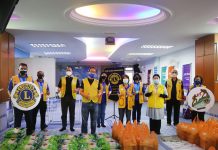It’s not easy being the Professor but you can tell from his smile he wouldn’t have it any other way.
Squatting six feet underground, at the bottom of a carefully measured square plot in the confines of a steamy humid cave near Kuala Pilah, Professor Datuk Dr Mokhtar Saidin sweeps away some dirt with a soft brush, scratches his head, leans against the muddy wall, then for three or four minutes makes some notes and draws some simple diagrams-it’s not the most glamorous part of the job done by USM Global Archaeology Research Centre director professor Mokhtar but to him it is exciting.
Students and colleagues surround his excavated area, occasionally ducking their heads as small bats fly past, all eagerly awaiting his experienced assessment of this newly revealed mystery.
There are no quick or easy answers when the evidence you find can be more than 10,000 years old and you are merely scratching at the surface, literally an inch at a time, to find leftover clues to try and ascertain and explain how life was back then.
The initial process of discovery and subsequent interpretation must be scientifically accurate and requires much patience and consideration.
It’s almost 6pm and the professor has an early 8am meeting at his University, USM in Penang, a minimum five-hour plus drive, so he emerges from his hole.
He is tired but also energised; it’s been a good couple of days on this third excavation of Gua Pelangi, near Kuala Pilah.
“We are really glad that Negeri Sembilan state have sponsored this third phase to the tune of RM90,000 through the NS museum, which will help us get a more detailed picture about this cave’” said Mokhtar.
“I really want to know what section of the cave they used for what purpose…we know what tools they used, what fauna they ate, but I want to find out more about this area,” he says, pointing to a grid area on his map, “because they look like small rooms-this can mean burial sites.”
“We did some geo-scans yesterday which revealed good data showing something about this place, it looks like skeletal data,” he says smiling.
Finding skeletons is always good when excavating but it can also be a hindrance.The physical removal is time consuming and recording data of a skeleton so old, slows down the overall excavation.
Nonetheless, it is exciting and bodes well for future excavations that will hopefully see ongoing commitments from the Negeri Sembilan State Government to develop the area into an archaeological-eco tourism area.
“I think they already know the importance of this cave and its surrounds as they are funding us now and hopefully we’ll see a small exhibition–museum on site here one day-we are so grateful for their help,” says Professor Mokhtar
The analysis of recorded data can take u to 6 months or longer depending on the complexity so the professor is hoping to excavate the older layers to gain more ideas about the habitation of the people and the usage of the cave.

“ We have some complex evidence here,” he says, as he returns to the deep excavation he just left and scrapes again the 10,000-year-old soil, and then makes another measurement of the solid mass of ash.
“This is usually evidence of a fire pit usage and there is a lot of ash here, but for some reason there is no soot above us on the ceiling or any residue in the earth surrounding it,” he says, “it is a mystery,’ he says with a pause, ‘for now.”
One gets the feeling this experienced and jovial professor and his colleagues will piece together a solution for this ancient jigsaw puzzle.
For more information about the Gua Pelangi cave and the activities and tours of the cave complex and surrounding areas contact Azliny on FB at ATOA Pasoh Caves. It’s a wonderful experience









































